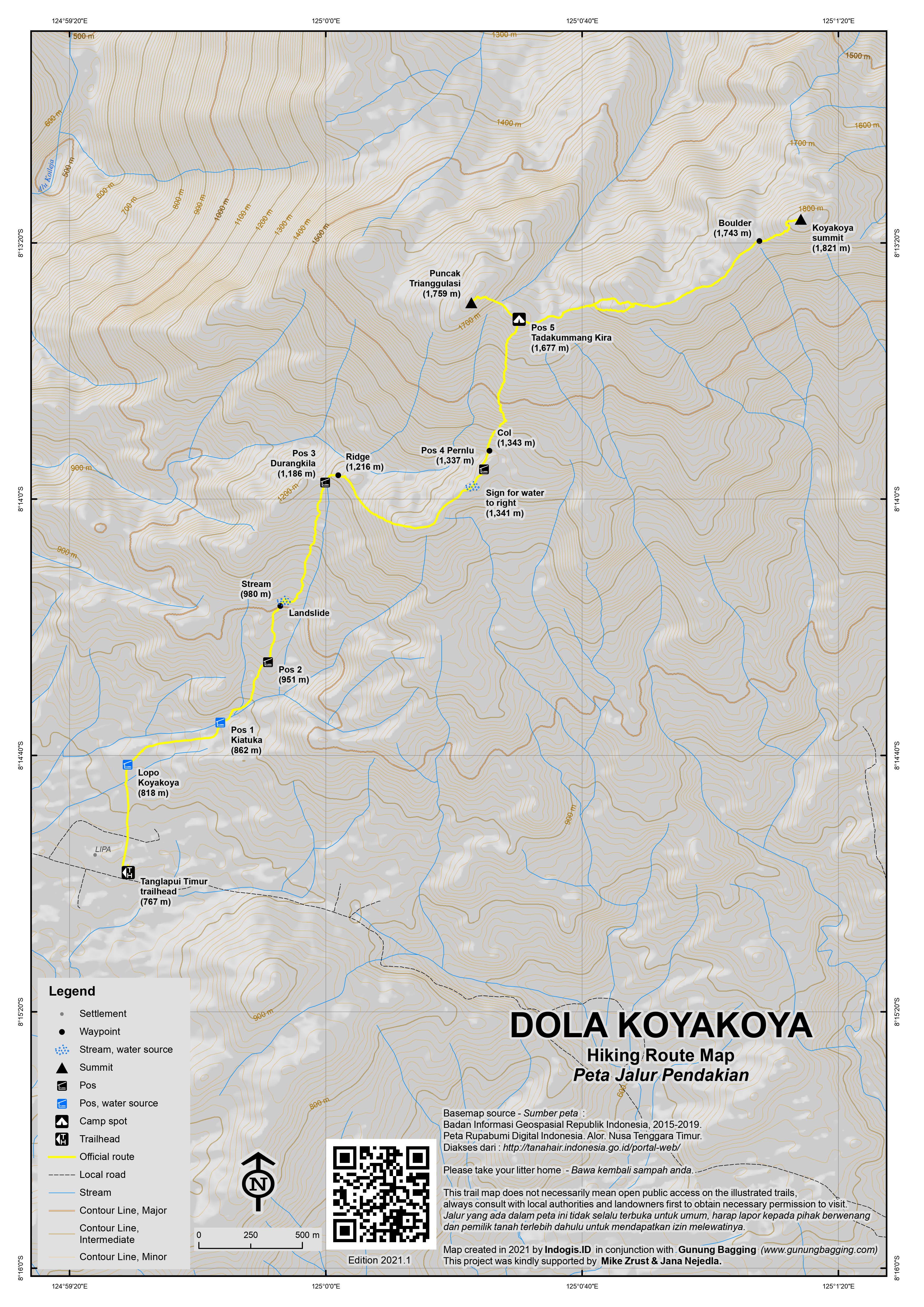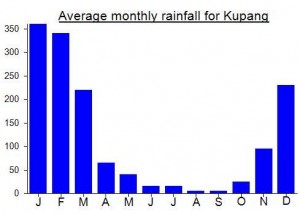Facts
- Elevation: 1,821 m (5,974 ft)
- Prominence: 1,821 m
- Ribu category: Kurang Tinggi
- Province: Nusa Tenggara Timur
- Google Earth: kml
- Rating:
- Other names: none
Photos
Bagging It!
Dola Koyakoya is the highest point of Alor island and is the last major peak in the island chain east of Java running all the way from Bali to Timor Leste (East Timor). It is home to a large number of deer and, like many of the highest hills from Lembata island eastwards, the higher slopes are incredibly scenic eucalyptus forest with plenty of distant views and reasonably easy walking.
Koyakoya is occasionally climbed, especially on August 17th by local hikers, and the traditional house at the trailhead in Tanglapui Timur has a guestbook and even a second traditional house or ‘lopo’ where hikers may stay a few minutes’ walk above the village and main road. The first time the trail was officially used by hikers was back in 2013. Look out on the main road from Kalabahi for signs for Kaipera and then Desa Kobra before the sign for Marten Modena’s Lopo Koya Koya on the left (767m).
Dola Koyakoya can be hiked in a single day if you set out early enough or stay close to the trailhead, but camping at Pos 5 is a good option too if you want the finest early morning views from the top. Allow around 4-5 hours up to Pos 5 where the trail splits to head towards two different peaks, 2 hours to explore the true summit (or just 1 hour if you prefer a slightly lower, closer and more popular viewpoint) and about 3 hours back down from Pos 5.
From the trailhead, the route follows a village track for a short distance before heading straight on along a narrower path to Lopo Koyakoya (818m). This is the traditional house where hikers can stay in normal times, though at the time of writing in May 2021, the building needs a bit of work after the recent Seroja storm which brought devastation to much of the Nusa Tenggara Timur province.
Behind the lopo, follow the cement water channel before veering left (857m) towards Pos 1 Kiatuka (862m), which is a stream that the trail crosses before entering bamboo forest and undergrowth. Here the sign reminds us to take care of our attitude and behaviour. The next landmark is a water tank (896m) before Pos 2 (952m) which in 2021 is not marked. It is thought to have been an ancestral burial spot. Beyond Pos 2 is a landslide area near a stream (980m) where the new path is steep and not always clear. Take care with route-finding and watch out for spiny plants.
Pos 3 Durangkila (1,186m) marks the beginning of a much better established path up a pleasant but occasionally very steep grassy ridge (1,216m). This is the spot where a sign commands us to ‘keep striving until the sheep become lions’! From here, the views are great back down to the valley where the trail started and also on the left up to the higher slopes of Koyakoya. It is also where you are likely to begin to see deer. The trail levels off for a while and is delightful walking when not in direct sunlight.
There is a sign at 1,341m for a water source on the right of the trail before Pos 4 Pernlu (1,337m) which according to the sign is regarded as a place of shelter. In previous times, this is where locals prepared deer meat after a hunt before descending to the villages. It should have taken you around 3 hours to reach this point. After a minor col, the trail starts to get much steeper and it can occasionally be quite frustrating with tiny stones in the grass making it easy to fall over.
There are a few more signs at this point, including one about edelweiss and another about taking memories home (1,591m). Finally the top of the ridge is reached. This is Pos 5 Tadakummang Kira (1,677m) and is the ideal spot to camp at. According to the sign, this is the war warriors’ treaty place, with local tribes agreeing to cease all fighting. There are a few small cairns here and the scenery is delightful. From here, you can see Puncak Trianggulasi on the left (north-west). You may even be able to see the cement pillar made by villagers at the top. On the Bakosurtanal map this peak is labelled Dola Potomana (1,759m) which is quite accidentally quite an apt name in Indonesian (photo where!) as it is a grand spot from which to take photographs.
From Pos 5 to Puncak Trianggulasi / Potomana is just 20 minutes but it is quite steep so do take care. There are various summit signs here next to the village-made cement pillar and it is clear that most hiking groups aim to get to this point rather than the true summit which is over 1.5km to the east. If you have time for both, our recommendation is to visit this spot first and then go to see out the true highest peak on the other side of Pos 5.
From Pos 5 heading north-east to the true summit of Koyakoya takes around 45 minutes (one way) and in clear weather it is fairly straightforward terrain despite few hikers visiting it. The last section is the hardest, with steep terrain and then a tiny little summit ridge with considerable drops on either side and crowned with cantigi shrubs and a summit sign erected by ‘anak bangsa’. The Bakosurtanal map gives an elevation of 1821m, and our GPS hovered around 1830-1833m. If anyone else gets a similar reading please let us know and we will officially increase the height by a few metres on the site.
A slightly lower peak lying just 500 metres to the south-east of Koyakoya summit is called Dola Doraniki (1,751m). And a further two kilometres to the south-east of Doraniki is a small upland lake called Ireaku Koyakoya, though it is not likely that either of these spots is visited on a regular basis except by deer.
Koyakoya can be seen clearly from Timor Leste’s Atauro island, and indeed from the higher slopes of Koyakoya the mainland of Timor Leste is visible, including the small nation’s highest peak Gunung Ramelau. These high ridges of Alor island are a great place to savour before descending back down to the village by the same route.
If you ask politely, the villagers may show you their traditional moko, an ancient metal drum that most Alor villages have, keep in the roofs of their traditional houses, and are used for dowry purposes. The local belief is that these objects are directly given by nature (‘alam’) but others suggest that they originate overseas from long, long ago. There is a museum in Kalabahi with detailed information and numerous examples.
Bagging information by Dan Quinn (May 2021)
Trail Map

For a high quality PDF version of this and other trail maps, please download from our Trail Maps page.
Local Accommodation
Practicalities
- Getting there: Fly to Alor’s Mali airport from Kupang, West Timor. Then it’s around 2.5 to 3 hours by road (85km) from the Kalabahi area to Tanglapui Timur trailhead at the top of the main road over to Marataing.
- Guides and GPS Tracks: Want a PDF version for your phone? Looking for a guide? Need GPS tracks and waypoints? Dola Koyakoya information pack can be downloaded here.
- Trip planning assistance: Would you like Gunung Bagging to personally help you in arranging your whole trip? Please contact us here.
- Permits: Register in the trailhead and write your name in the book which has been kept since 2017.
- Water sources: Always available at Pos 1 (862m), and beyond Pos 2 (at around 980m). Usually available off the trail at a sign to ‘sumber air’ on the right (1,341m) and beyond Pos 5 (1,677m) but you may need a local guide for help with this and the sources may not be available higher up in the dry season.
Local Average Monthly Rainfall (mm):


 (1 votes) Add your rating
(1 votes) Add your rating
Had a fantastic trip to Alor and Pantar last week. The whole thing was quite uncertain due to the horrendous destruction wrought on the islands by the Seroja storm. Indeed we met one chap on Pantar who said he had to start again from zero. But the main roads are at least passable on both islands now. Over in Kupang there are one or two brand new ‘lakes’ created by the sheer power of the storm. Perhaps storm is wrong word.
The road out of Kalabahi up into the hills in the east is incredibly scenic, followng the coastline for a fair distance. Google reckoned just over 2 hours but it was closer to 3 by the time we got the village.
The Lopo Koya Koya sign at the side of the road was still toppled over, perhaps since the storm. We got started fairly quickly, having arrived a bit late in the afternoon, and still hoping to reach Pos 5 and camp there. Well, we made it, with a more-or-less full moon to help us part of the way. The lower sections of trail have been affected by landslides from the storm in early April and you wouldn’t want to do those in the dark at present. The darkness may have been a blessing beyond Pos 3 where the ridge gets steeper. We could see the lights of East Timor in the distance.
In this area you often hear gongs being struck down in the villages, typically on the hour when there is a meeting or some kind of traditional task that needs taking care of. It was quite beautiful. For hikers, upon hearing these gong beats you are supposed to take a short break. We were quite happy to do that on the final slog up to Pos 5. We didn’t get a good look at the deer, but saw plenty of their eyes in the dark and heard them. Apparently as of early 2021 there are new restrictions on hunting them.
A bit of low cloud or mist up there, with the full moon. Stunning. Reminded me of Lembata’s Ili Uyelewun. I can see why some locals think the place is haunted but we slept pretty well.
At 5am we were up and quickly on our way to Puncak Trianggulasi for what the guides claimed were the best views.
Indeed it is very pleasant indeed. But we didn’t wait around too long at the cement pillar as we were more interested in the true summit that very few people bother with. Lots of green and yellow cockatoos flying about near Pos 5.
It was a lovely 45-50min stroll over there in the early morning sunshine and then back again and down and a look at the village moko, or at least one of them.
Back down in Kalabahi we checked in at the Mokkolipa Guesthouse – a new place, well-designed and has everything you need. Perfect and reasonable price. Recommended. But for views at sunset and some culinary treats, walk over to the rooftop bar and café at Hotel Symfony. In clear weather you can see Pulau Pura and even Gunung Sirung in the distance.
Pingback: Dola Koyakoya: Hiking the Haunted Mountain of Alor Island - Quit and Go Travel